Statistics for Egg Becoming a Baby Based on Rating
Download the underlying data set in .xlsx (151kb).
Download a PDF version of this written report (1.04mb).
Table of contents
- Main points
- Department 1. IVF birth rates have increased for patients nether 43 years
- Department 2. Birth rates were to a higher place twenty% per embryo transferred on average in the first three cycles
- Section 3. Using donor eggs can event in high birth rates for older patients, but they are non widely used
- Section 4. The multiple nascence rate decreased further to viii% in 2018
- Section 5. Transferring more than i embryo could result in a multiple birth rate over 30%
- Section vi. Embryo and egg storage have increased as freezing becomes more mutual
- Section seven. NHS-funded cycles decreased in many English regions
- Department eight. Fewer patients had their kickoff IVF bicycle funded by the NHS
- Virtually our information
Main points
- About 54,000 patients had 68,724 fresh and frozen in-vitro fertilisation (IVF) cycles and 5,651 donor insemination (DI) cycles at HFEA licensed fertility clinics in the United kingdom in 2018.
- In 2018, the average birth rate per embryo transferred for all IVF patients was 23% and rates accept steadily increased over time for all patients anile nether 43.
- In 2018, birth rates for patients beneath 35 were 31% per embryo transferred, compared to below 5% for patients 43 and above when using their own eggs.
- The alive birth rate per embryo transferred remains to a higher place twenty% for each of the first three cycles of IVF treatment.
- Donor eggs can considerably increase the chance of a live birth to higher up 25%, but only 18% of patients aged 40 and older used donor eggs in 2018.
- The multiple birth rate decreased to 8% in 2018 for the first fourth dimension.
- Implanting more than one embryo has no significant touch on on the chance of a live birth but results in a 32% multiple birth rate for patients under 35.
- Since 2013, the number of egg and embryo storage cycles increased fivefold to just under 9,000 cycles in 2018 as freezing techniques improved and have become more commonplace.
- The level of NHS funding for fertility handling varies across the Uk with sixty% of cycles funded by the NHS in Scotland and falling to less than 30% in some parts of England.
1. IVF nascence rates take increased for patients nether 43 years
About 54,000 patients had 68,724 fresh and frozen in-vitro fecundation (IVF) cycles and 5,651 donor insemination (DI) cycles at HFEA licensed fertility clinics in the U.k. in 2018. Later years of rapid growth in the number of treatment cycles, these have begun to stabilise.
Birth rates from IVF have steadily increased over fourth dimension with the average nativity rate per embryo transferred at 23% in 2018. Patients under 35 had the highest nascence rate per embryo transferred at 31% in 2018, compared to just ix% when the HFEA was established in 1991.
The average age of an IVF patient was 35.3 years in 2018; age is a central factor to consider when looking at nascence rates, as fertility decreases with age. In 2018, nativity rates per embryo transferred were 25% for patients aged 35-37, 19% for patients aged 38-39, and 11% for patients anile xl-42.
Clinical improvements have led to increased chances of a live birth for all patients below 43 years old. In 2018, patients aged 40-42 had a higher chance of a live birth (xi% per embryo transferred) than patients aged nether 35 in 1991 (ix% per embryo transferred). Patients aged 43 and above have consistently had nascence rates below 5% per embryo transferred when using their ain eggs. In department 3 nosotros discuss how donor eggs can increase chances of success for older patients to higher up 20% on average.
Figure one. Birth rates have increased for all patients below 43 years of age since 1991
Nascency rates per embryo transferred using patient eggs by historic period band, 1991-2018
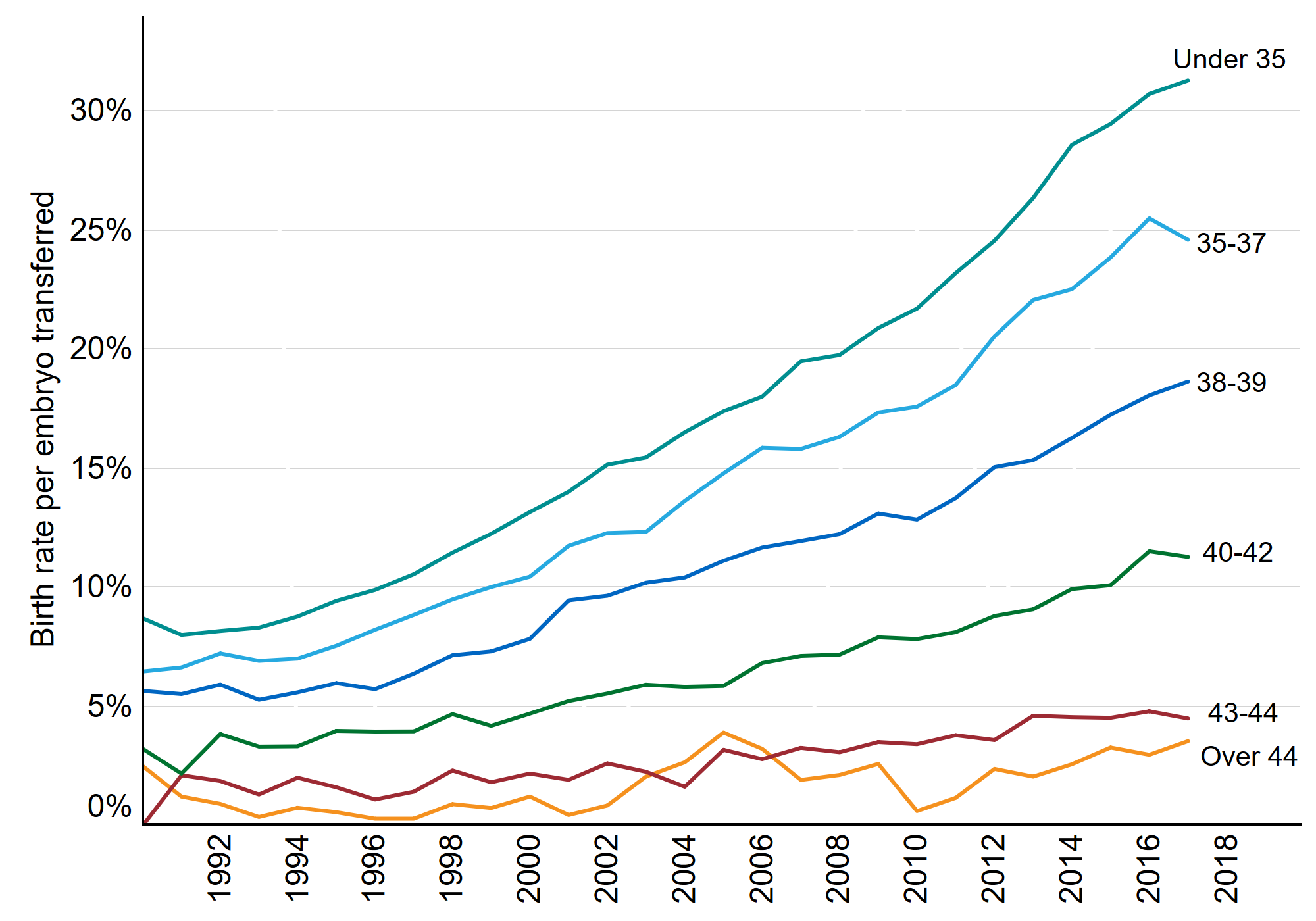
Effigy 1 Notation: This data includes treatment now only, IVF, Patient egg. It excludes fresh and frozen PGD and PGS, surrogacy, and cycles where pregnancy was recorded but not consequence.
Download the underlying information for Figure 1 every bit .xlsx (163KB).
If yous require the data for Figure 1 in an alternative accessible format, delight email comms@hfea.gov.uk.
two. Birth rates were above 20% per embryo transferred on average in the first 3 cycles
On average, about 1 in every iv embryos transferred resulted in a live nativity in 2018. Equally a event, many patients volition have more than one circular of embryo transfer; the average patient has three rounds.
The figure below shows the chances of a live birth by cycle number in 2018. The boilerplate age of a patient on their first cycle was 34.4 (green line) and their take chances of having a live birth on that wheel was 26% per embryo transferred (blue column). By contrast, the average age of a patient on their 10th bicycle was 38.9 and their chance of having a live birth on that cycle was 12% per embryo transferred.
The birth rate remains to a higher place 20% per embryo transferred for each of the commencement three cycles and steadily decreases with each new cycle. The reason the average birth rate is lower in later on cycles is related to the average patient age, as older patients have lower nascence rates and therefore require more cycles (see section 1).
Figure 2. Birth rates per embryo transferred were in a higher place 20% on average in offset three IVF cycles
Birth rates per embryo transferred using patient eggs by cycle number and patient historic period, 2018
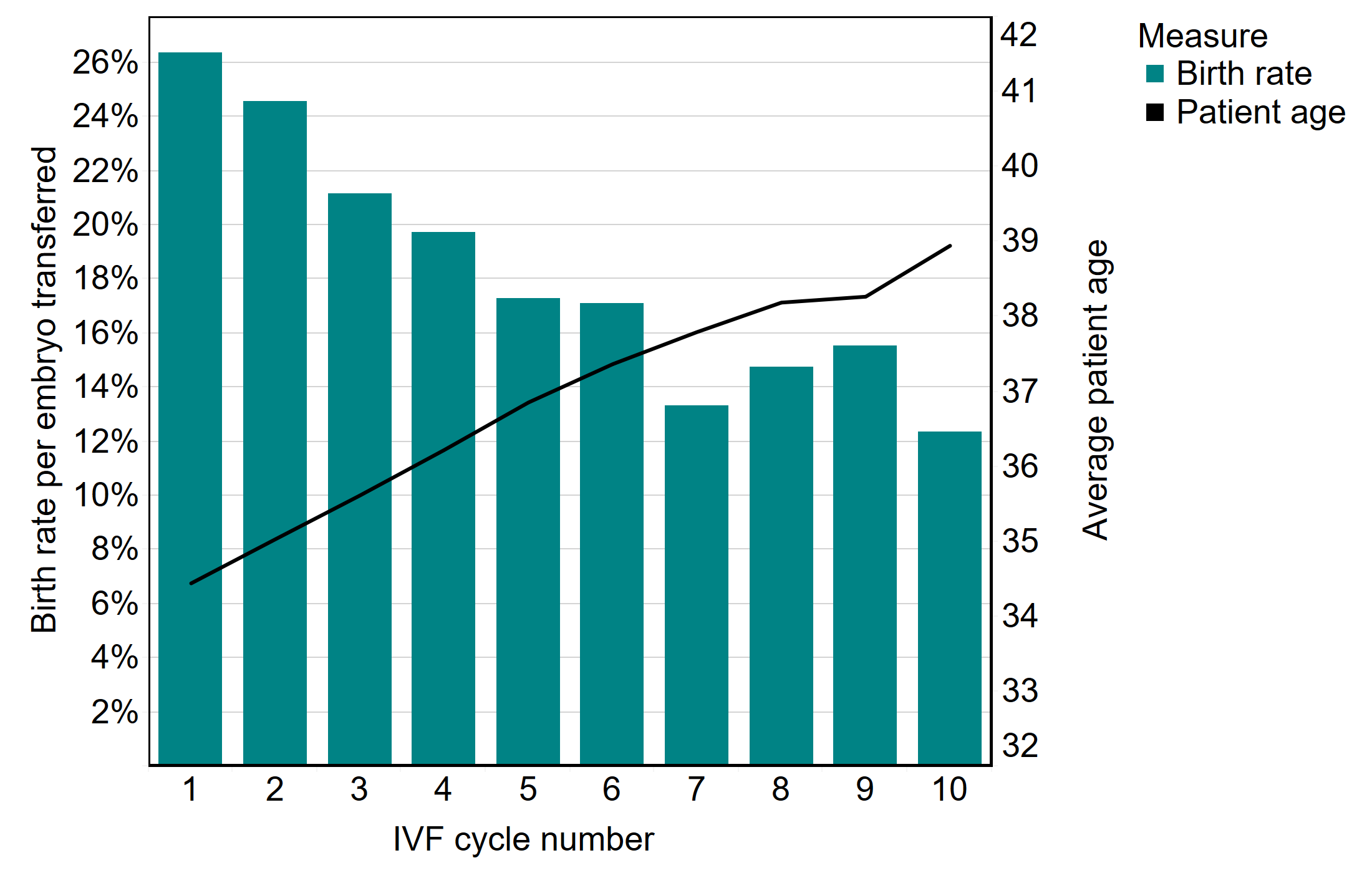
Figure 2 Note: This information includes treatment now but, IVF, Patient egg. Information technology excludes fresh and frozen PGD and PGS, surrogacy, and cycles where pregnancy was recorded but not outcome.
Download the underlying data for Figure 2 equally .xlsx (154KB)
If you crave the data for Figure ii in an culling accessible format, delight electronic mail comms@hfea.gov.uk.
three. Using donor eggs tin can result in loftier birth rates for older patients, but they are not widely used
Birth rates decrease with age where patients use their ain eggs in treatment. In 2018, nativity rates for patients below 35 were 31% per embryo transferred, compared to beneath 5% for patients 43 and above.
However, birth rates remained college (above 25%) for all ages when donor eggs were used as egg donors are five years younger on boilerplate (xxx.two) than IVF patients (35.vi).
Effigy iii. Birth rates remain above 25% for all ages where donor eggs are used
Birth rates per embryo transferred by age bands and egg source, 2018
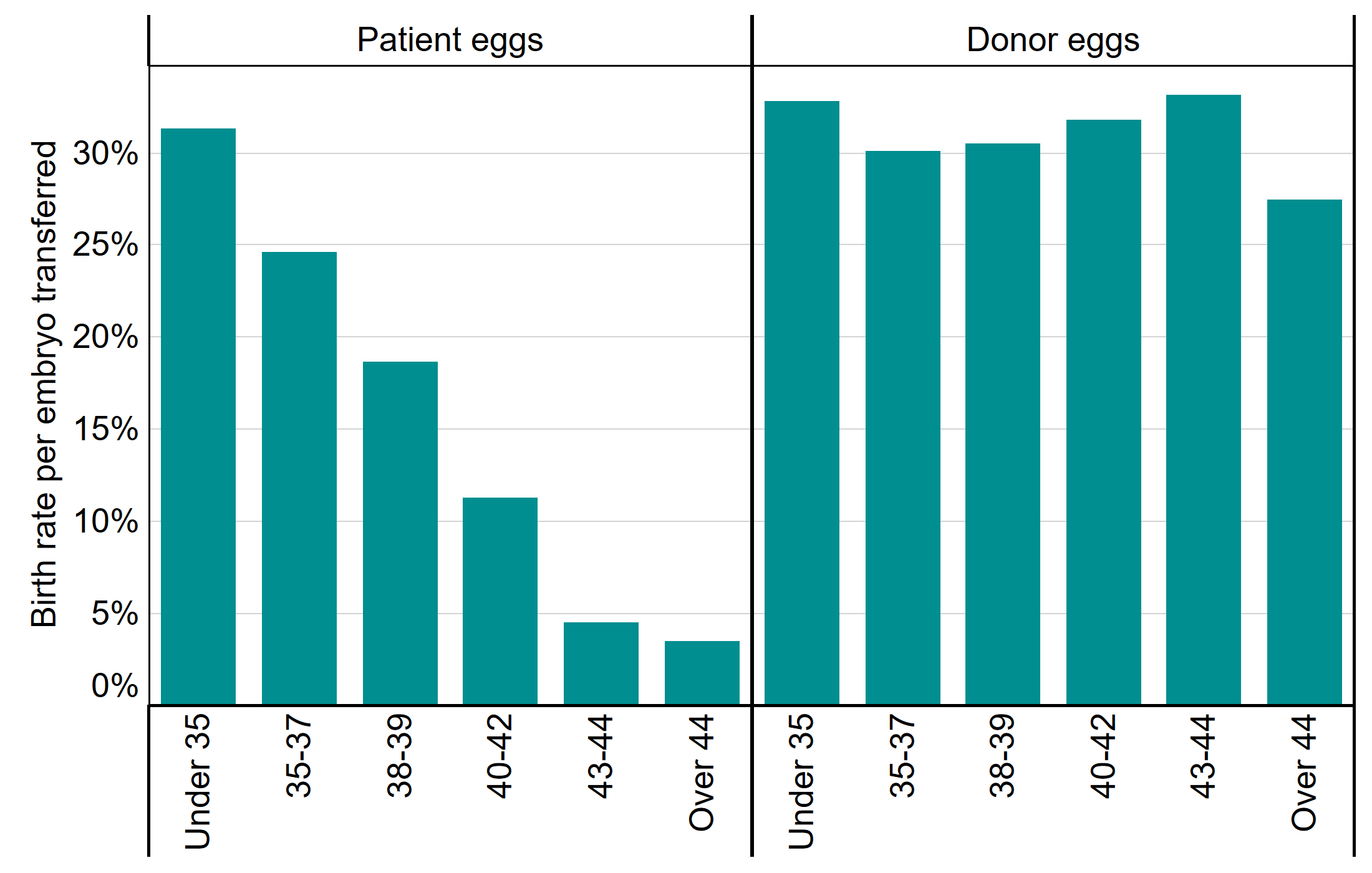
Figure 3 Notation: This data includes handling now merely, IVF, Patient egg. It excludes fresh and frozen PGD and PGS, surrogacy, and cycles where pregnancy was recorded only non outcome.
Download the underlying data for Effigy 3 equally .xlsx (152KB)
If yous require the data for Figure iii in an culling accessible format, please email comms@hfea.gov.u.k..
Although it is clear from the effigy above that donor eggs can considerably increase the take chances of a alive nascence for patients twoscore years of historic period and older, only 18% of patients in this age group used donor eggs in 2018. In particular, while birth rates were comparably low for patients aged 43-44 (5%) and patients above 44 (4%) using their own eggs, patients above 44 years were 3 time more likely to employ donor eggs.
Of all patients undergoing IVF handling in 2018, 94.4% were in heterosexual relationships, 3.1% were in female same-sexual practice relationships, 2.0% had no partner and 0.5% acted every bit surrogates – with little change compared to 2017. While accounting for less than 5.5% of all IVF treatments, single patients, those in female same-sex relationships and surrogates accounted for 46% of all IVF cycles using donor gametes in patients under twoscore.
Figure 4. Donor eggs are used about past those patients over 44
Proportion of IVF cycles using donor sperm/eggs by age ring, 2018
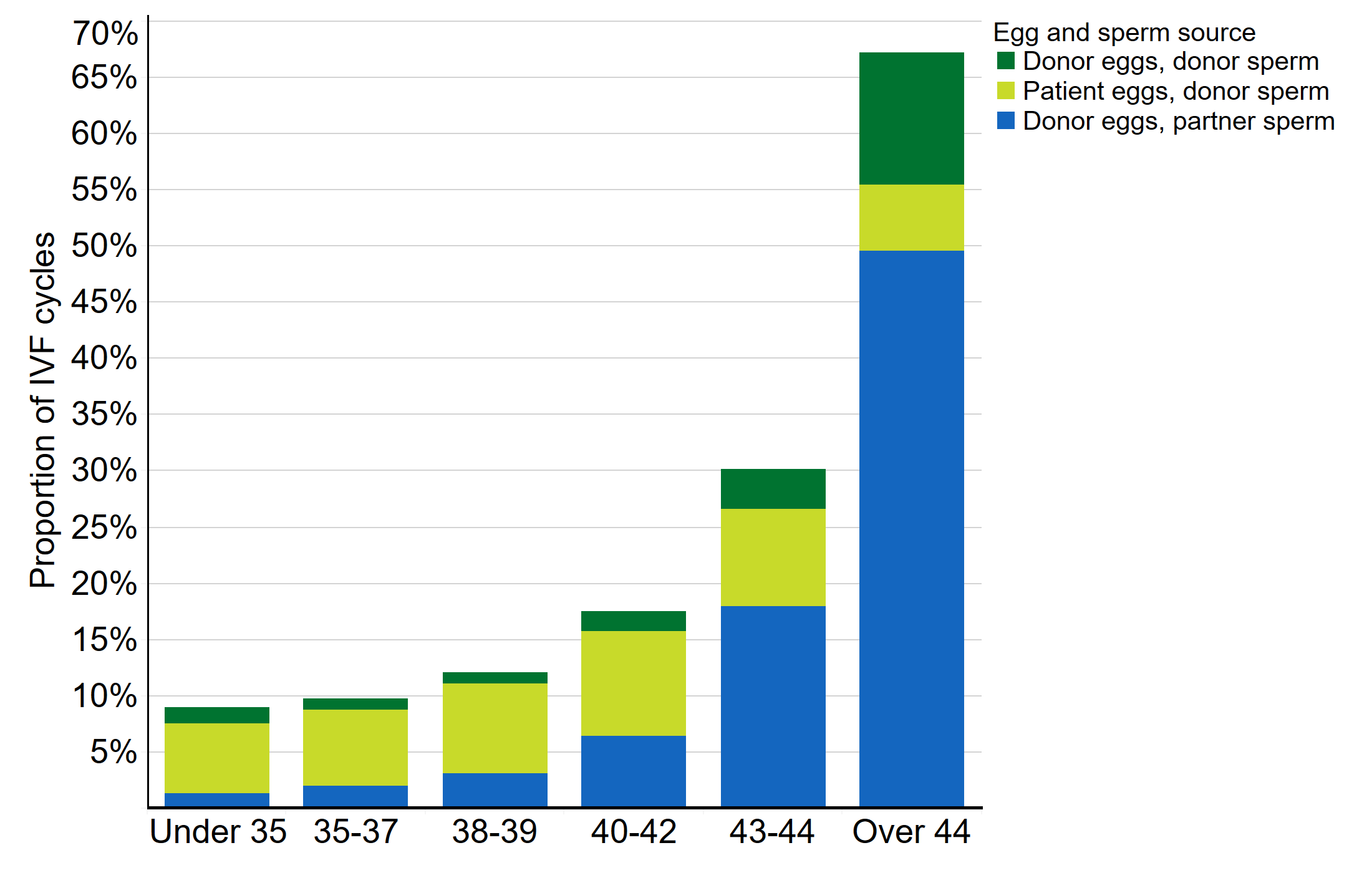
Figure iv Note: This information includes treatment now and IVF only.
Download the underlying data for Figure 4 as .xlsx (154KB)
If yous require the data for Figure 4 in an alternative accessible format, please email comms@hfea.gov.u.k..
4. The multiple birth charge per unit decreased further to 8% in 2018
Multiple births are the biggest unmarried wellness take a chance from IVF to mothers and babies. In 2017, the 10% multiple birth rate target was accomplished for the first time nationally, but not across all age groups. In 2018, farther progress was made, as the 10% target was reached across all age groups and nationally only viii% of IVF births resulted in a multiple birth.
Figure 5. The 10% multiple birth target has been reached in all patient age groups
Multiple birth rates past historic period group, 2017 and 2018
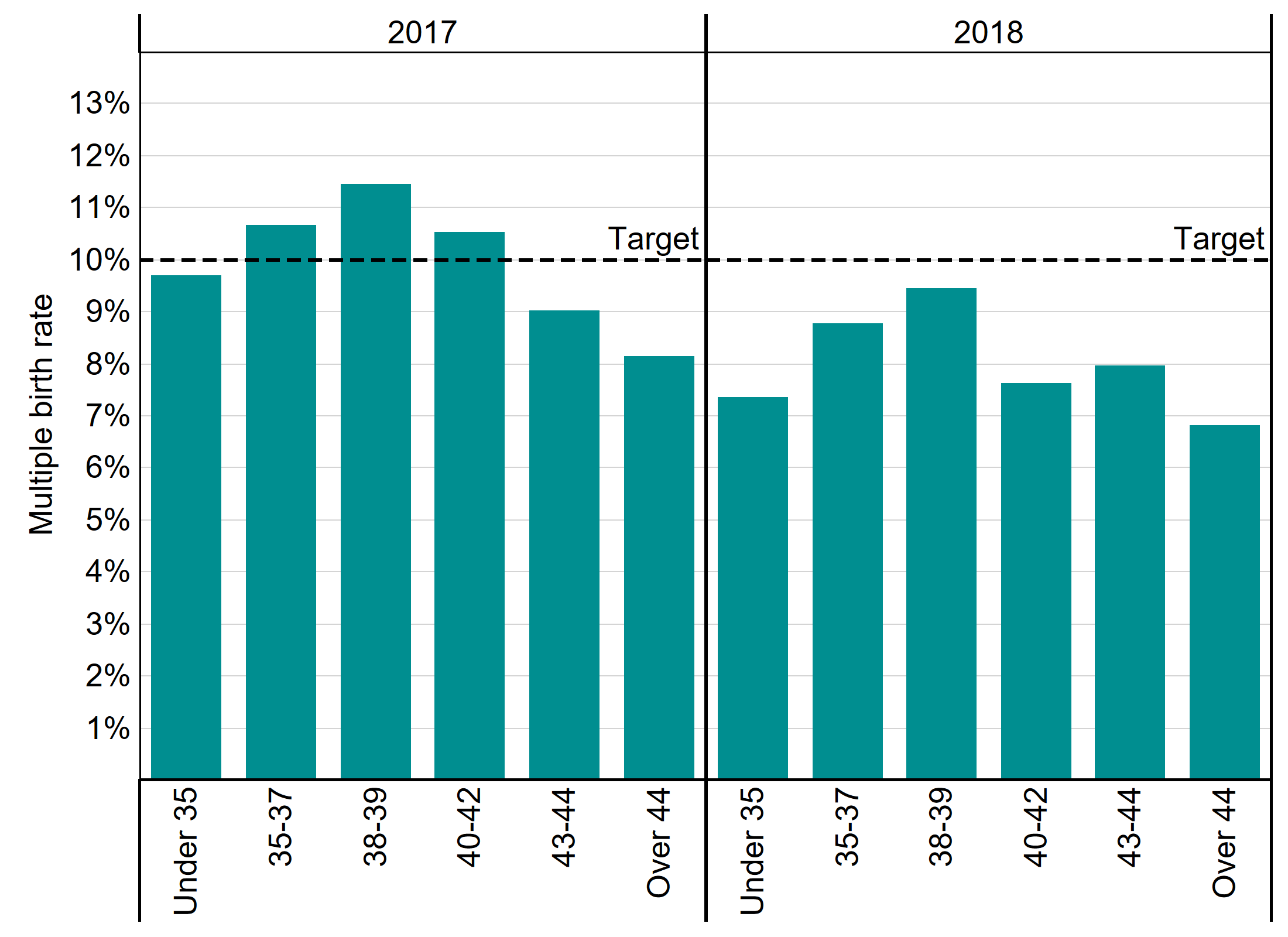
Figure 5 Note: This data includes handling now and IVF only. It excludes cycles where pregnancy was recorded only not issue.
Download the underlying information for Figure 5 every bit .xlsx (154KB)
If you lot require the information for Figure 5 in an alternative accessible format, delight e-mail comms@hfea.gov.uk.
5. Transferring more than i embryo could result in a multiple birth rate over 30%
For each patient, the run a risk of a multiple birth is determined by the number of embryos put back and whether donor eggs were used. Our figures show that putting more than one embryo back has no meaning bear upon on the chance of a live birth just tin can considerably increment the risk of a multiple nascence.
Equally the effigy beneath shows, the risk of a multiple birth in IVF is comparable to natural formulation (two%), when only a single embryo is put back. Where two embryos were transferred, all the same, in that location was a 32% risk of a multiple birth for patients nether 35, without an increase in the chance of a live birth. In 2018, 21% of IVF cycles in patients under 35 had a double embryo transfer.
The conclusion to transfer more than 1 embryo at a fourth dimension should also consider the egg source. When two embryos were transferred, a 44-yr-quondam patient using donor eggs had about the same multiple birth risk as a 35-twelvemonth-one-time using their ain eggs. Of all cycles using donor eggs in patients 40 and over in 2018, 18% transferred back more than than one embryo.
Effigy six. Single embryo transfers are the safest pick for patients of all ages
Multiple birth rate by egg source and number of embryos transferred, UK, 2018
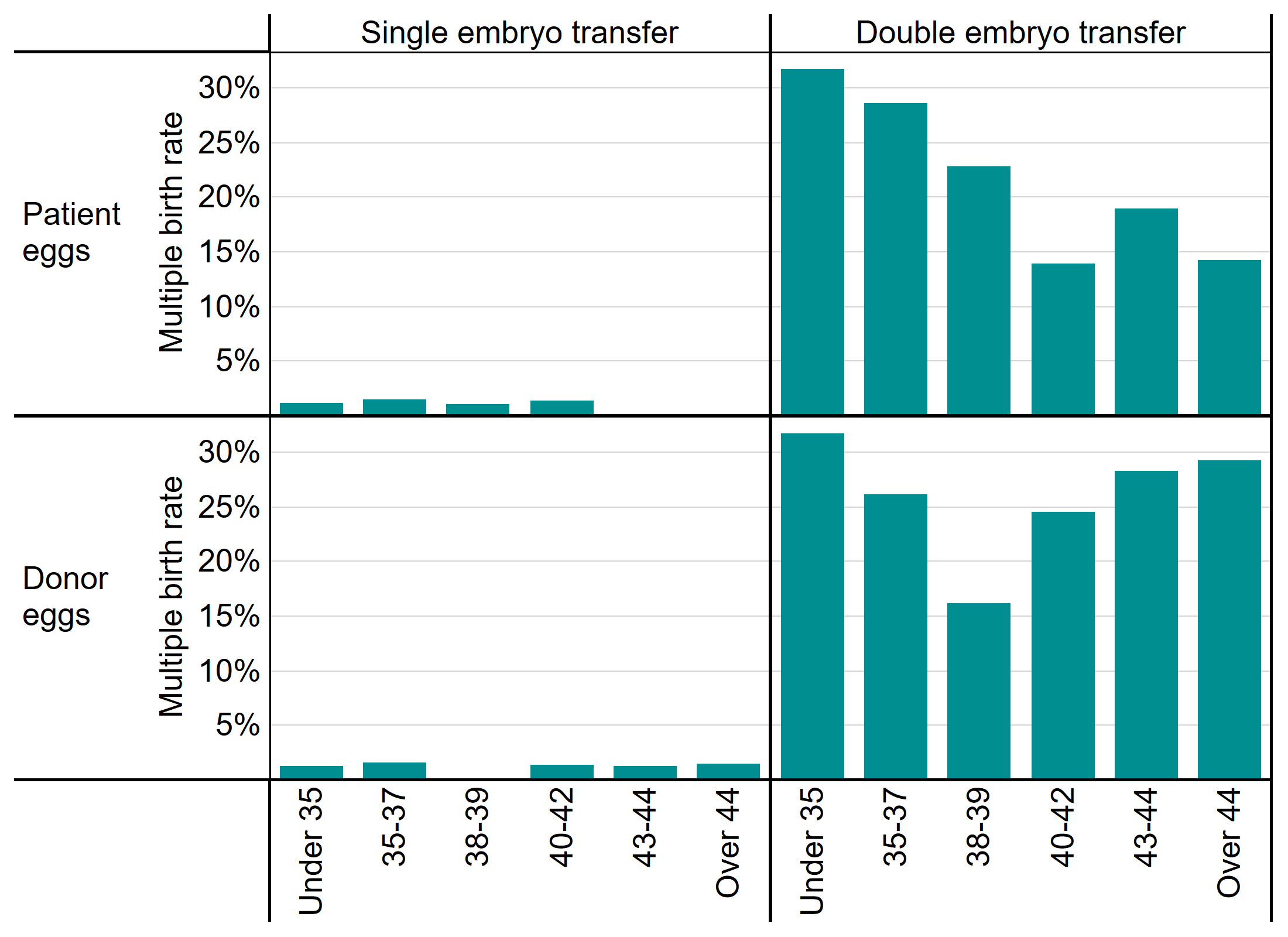
Figure 6 Note: This data includes treatment now and IVF but. Information technology excludes cycles where pregnancy was recorded but not event.
Download the underlying information for Figure 6 as .xlsx (154KB)
If y'all require the data for Figure 6 in an alternative attainable format, please email comms@hfea.gov.uk.
half dozen. Embryo and egg storage have increased equally freezing becomes more common
The majority of patients using fertility services practice so with the intention of trying to excogitate equally soon as possible. However, at that place are other reasons people may use fertility services: to store their eggs and/or embryos for futurity use for fertility preservation; or to donate their eggs, sperm or embryos for use by another patient. While handling cycles increased by 12% betwixt 2013 and 2018, storage cycles increased much more than quickly, increasing by 523% from i,500 cycles in 2013 to just under 9,000 in 2018.
Equally freezing techniques have improved, a typical patient today will have a unmarried, fresh embryo transferred in their first cycle and whatsoever additional embryos created will be stored for use in subsequent frozen embryo transfers. Elective freeze-all cycles – where all fresh embryos are frozen after IVF to be used in later cycles – have as well get more than common. Equally a result, fresh embryo transfers decreased past eleven% between 2013 and 2018, while frozen embryo transfers almost doubled and accounted for 38% of all IVF cycles in 2018.
Table 1. Egg and embryo storage as well as frozen embryo IVF cycles are the fastest growing activities
| 2013 | 2018 | % alter | |
|---|---|---|---|
| Fresh embryo transfer | 48,391 | 42,835 | -xi% |
| Frozen embryo transfer | thirteen,421 | 25,889 | +93% |
| Donor insemination | 4,642 | five,651 | +22% |
| Treatment total | 66,454 | 74,375 | +12% |
| Embryo storage | 871 | vii,031 | +707% |
| Egg storage | 569 | 1,933 | +240% |
| Storage total | i,440 | 8,964 | +523% |
| Donation | i,393 | 1,916 | +38% |
| Egg share | 765 | 381 | -50% |
| Donation total | two,158 | 2,297 | +6% |
Download the underlying data for Table one as .xlsx (155KB)
If you crave the data for Table 1 in an alternative accessible format, please email comms@hfea.gov.united kingdom.
vii. NHS-funded cycles decreased in many English regions
In 2018 in Scotland, 60% of handling was NHS-funded, compared to 45% in Northern Ireland, 41% in Wales and 35% in England. In Scotland, Wales and Northern Ireland, the level of funding is set nationally. In England, funding is locally determined by Clinical Commissioning Groups (CCGs) leading to considerable regional variation in funding, as seen in the table below. In England, many CCGs take reduced funding for fertility treatment and as a result, the share of IVF cycles funded by the NHS has declined beyond nearly regions. The biggest decreases were seen in the E of England likewise as Yorkshire and the Humber, decreasing the England-broad share to 35% (41% in 2013).
Table 2. Funding trends are diverging nationally and regionally, with the overall number of NHS funded cycles declining
| UK nation | % of cycles funded by NHS | ||
|---|---|---|---|
| IVF cycles in 2018 | 2013 | 2018 | |
| England | 59,153 | 41% | 35% |
| London | 22,406 | 29% | 27% |
| N Due west England | 8,319 | 51% | 55% |
| South East England | vii,521 | 42% | 32% |
| West Midlands | iv,370 | 47% | 40% |
| Yorkshire and Humber | three,961 | 45% | 26% |
| East Midlands | iii,569 | 37% | 34% |
| East of England | 3,748 | 55% | 26% |
| South West England | 2,943 | fifty% | 41% |
| N East England | 2,316 | 60% | threescore% |
| Scotland | five,060 | 51% | 60% |
| Wales | 2,689 | 23% | 41% |
| Northern Ireland | 1,853 | 45% | 45% |
Tabular array ii Notation: This information includes treatment now and IVF only
Download the underlying data for Tabular array ii every bit .xlsx (155KB)
If you require the data for Table 2 in an alternative accessible format, please email comms@hfea.gov.uk.
8. Fewer patients had their first IVF bicycle funded by the NHS
As discussed in section 7, many English language regions have seen a decrease in the proportion of treatments funded by the NHS. As a result, approximately 2,000 fewer patients had their first circular of treatment funded by the NHS in 2018 compared to 2017, while treatments in the private sector connected to grow. In 2018, 52% of get-go IVF cycles were funded by the NHS, compared to 58% in 2017.
Effigy 7. Start cycles are nigh likely to be NHS funded, just this has decreased over time
Number of cycles by funding type and bicycle number, UK, 2009-2018
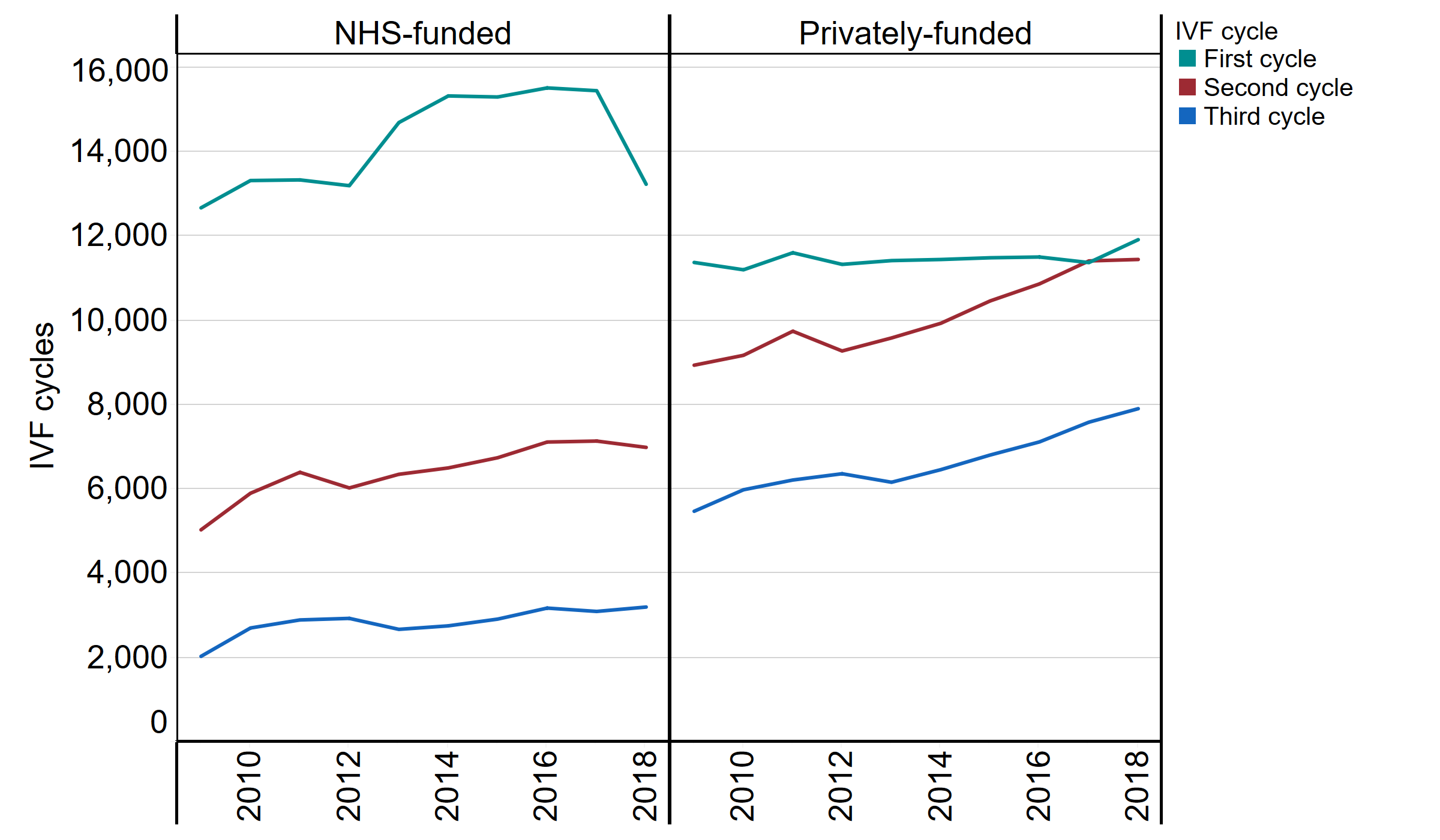
Figure 7 Note: This data includes treatment now and IVF only
Download the underlying data for Figure vii as .xlsx (152KB)
If you require the data for Figure 7 in an alternative accessible format, please electronic mail comms@hfea.gov.u.k..
About our data
The information that nosotros publish is a snapshot of data provided to us past licensed clinics. The figures supplied in this written report are from our data warehouse containing Register data as at 07/01/2020. Nosotros have excluded approximately 850 cycles due to technical issues at ane heart that resulted in reporting errors. Results are published according to the year in which the bike was started. For further information, please see our quality and methodology study.
Contact us regarding this publication
Media: press.function@hfea.gov.united kingdom of great britain and northern ireland
Statistical: intelligenceteam@hfea.gov.uk
buffingtonpearouble.blogspot.com
Source: https://www.hfea.gov.uk/about-us/publications/research-and-data/fertility-treatment-2018-trends-and-figures/
0 Response to "Statistics for Egg Becoming a Baby Based on Rating"
Post a Comment